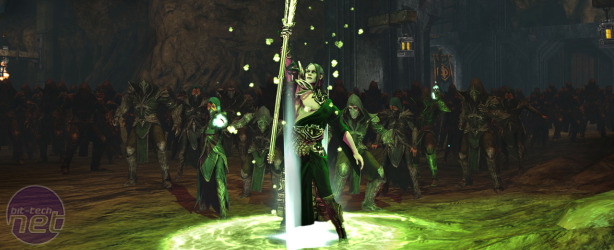
Dungeons & Dragons: Daggerdale PC Review
It doesn’t get any better when you look at the minutiae of how levelling works either; nearly all the special abilities and attacks available in Daggerdale are boring, generic attacks. The Human Fighter character especially suffers from having special attacks that are difficult to aim at enemies, mainly because they're made up of several individual blows.That said, we did find ourselves liking some of the small differences between classes and how they mesh with the character concept as a whole. Defensive options for each class can vary, for example, with the Human Fighter using his shield to absorb and mitigate damage, while the Elven Rogue is unable to block and instead dodges away from enemies. It’s a small variation, but it makes a subtle difference to how the characters feel as you play.
‘Play’ is perhaps a grandiose term for what playing Daggerdale feels like, however. The endless slog through boring goblins and skeletons and Zhentarim means this is more a game that’s ‘endured’, rather than ‘played’.
As usual, multiplayer is the saving grace for Daggerdale, and this is clearly how the game is supposed to be played. While the experience of enduring Daggerdale is certainly better when it’s done with friends, though, it’s hard to heap praise at Daggerdale’s feet because of this. Almost every game feels better when you’re playing it with friends, and there’s certainly nothing in Daggerdale which takes it above the norm in this regard. There are no tactics you need to plot in advance, no group attack abilities that can be rolled out against tougher foes; nothing. It’s just the same game, but with more players in it.
One of the issues that bugged us most of all, however, was the poorly designed user interface that had clearly been ported from the console system. There are dozens of tiny niggles and problems throughout, from the inability to pan the map around your character to the fact that you can’t sell equipped items straight from your person.
If such a person as a Daggerdale defender exists, they’d likely try to reason away some of these flaws by pointing out that Daggerdale is ‘only’ a downloadable, budget game. It’s therefore unrealistic to have AAA expectations of it, right?
Check the Trailers Section for more videos
Well, that’s only part true. Firstly, the RRP of £9.99 means that Daggerdale isn’t exactly a budget title and already faces stiff competition from other games. That price could get you six hours of disappointment with Daggerdale, or many more dozens of hours with the vastly superior Torchlight.
Secondly, while Daggerdale’s downloadable distribution and low price point mean that we’re willing to overlook frustrations such as the poor graphics, poor design is an entirely different matter. Daggerdale, with its awkward interface and terrible, dull setting and plot, suffers from both problems – it’s both ugly and bad.
Dungeons & Dragons: Daggerdale had huge potential, even within the limits of its predictable and formulaic hack-and-slash genre. Atari, however, has ignored the possibilities of the franchise in favour of delivering a rushed and poorly-ported title that will be expanded with later DLC and sequels. The result is a game that’s functional in the strictest sense of the word, but still ugly and uninspiring.
-
Overall20 / 100


MSI MPG Velox 100R Chassis Review
October 14 2021 | 15:04










Want to comment? Please log in.